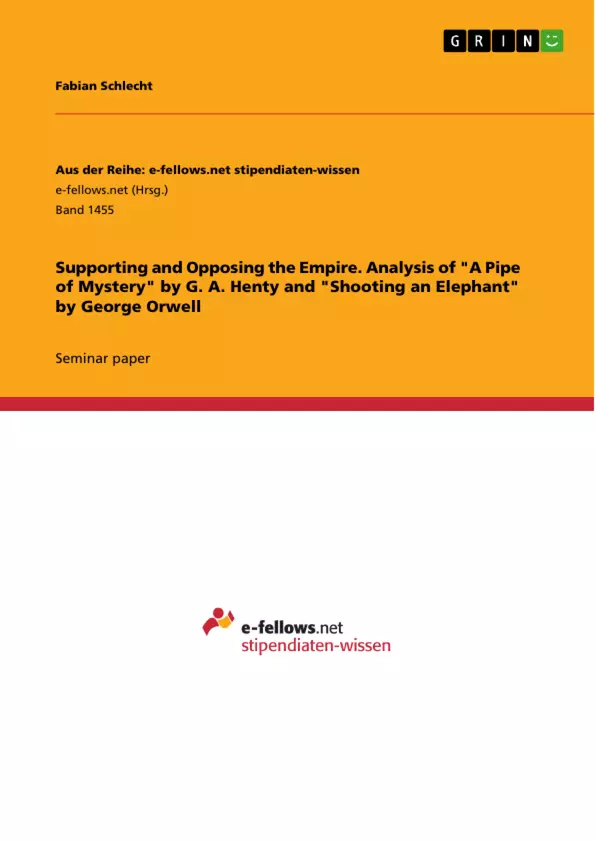This work is written in American English, reflecting in grammar, vocabulary, orthography and style. It will deal with one short story "A Pipe of Mystery" by George Alfred Henty and the essay "Shooting an Elephant" by George Orwell. Its aims are the following: finding the texts’ elements in support of colonial rule and those that oppose it; drawing up an analysis of these elements; and evaluating each author’s position on imperialism.
The text below will be divided into three parts, the first two being the analysis of each short story, and the third containing a summary of both analyses and a comparison. Each analysis will begin with a brief synopsis of the plot, some information about the author, and a short historical abstract. The actual analysis will follow.
Henty’s text was published as part of the five-story collection Tales of Daring and Danger, published around 1890. Orwell’s essay was published in a collection with the title Shooting an Elephant and Other Essays. While actually fitting the genre, the essay is not a short story because it does contain strong autobiographic references. One could best describe Shooting an Elephant as a hybridization between a political essay, a short story and an autobiography.
Table of Contents
- Introduction
- G. A. Henty's A Pipe of Mystery
- SYNOPSIS, AUTHOR AND HISTORICAL BACKGROUND
- ANALYSIS
- NARRATION AND FOCALIZATION
- HENTY AND HISTORY
- CHARACTERIZATION
- George Orwell's Shooting an Elephant
- SYNOPSIS, AUTHOR AND HISTORICAL BACKGROUND
- ANALYSIS
- NARRATION AND FOCALIZATION
- ORWELL'S STANCE ON IMPERIALISM
- CHARACTERIZATION, IMAGES AND SETTING
- Summary and comparison
- Literature and sources
Objectives and Key Themes
This work examines two short stories, A Pipe of Mystery by George Alfred Henty and Shooting an Elephant by George Orwell. The analysis aims to identify elements within the texts that support or oppose colonial rule, analyze these elements, and evaluate each author's position on imperialism.
- Representation of colonial power dynamics
- Exploration of perspectives on imperialism
- Analysis of narrative techniques and focalization
- Historical context and its influence on the stories
- Character portrayal and their relationship to colonial ideology
Chapter Summaries
The first part of the analysis focuses on A Pipe of Mystery, a typical colonial adventure story by Henty. The summary details the plot, provides information about Henty's life and writing style, and discusses the historical background of the Great Indian Mutiny of 1857. The analysis examines the narrative structure, Henty's historical perspective, and the characterization of the story's protagonists.
The second part of the analysis examines Orwell's essay Shooting an Elephant. It explores the narrative structure, Orwell's stance on imperialism, and the characterization, imagery, and setting of the essay.
Keywords
The primary focus of this work lies on colonial literature, imperialism, narrative analysis, and character portrayal. The texts examined highlight the complex relationship between British colonialism, historical events, and individual experiences. Keywords include: colonial adventure story, historical fiction, narrative focalization, imperial ideology, character analysis, and the Great Indian Mutiny.
- Quote paper
- Fabian Schlecht (Author), 2011, Supporting and Opposing the Empire. Analysis of "A Pipe of Mystery" by G. A. Henty and "Shooting an Elephant" by George Orwell, Munich, GRIN Verlag, https://www.grin.com/document/300368



